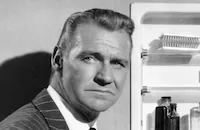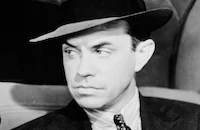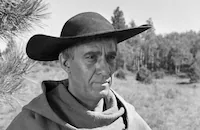The Virginian

Brief Synopsis
Cast & Crew
Stuart Gilmore
Joel Mccrea
Brian Donlevy
Sonny Tufts
Barbara Britton
Fay Bainter
Film Details
Technical Specs

Synopsis
In 1885, Molly Wood, who is from a prominent Bennington, Vermont family, decides that she wants more from life than her socially acceptable but static existence can offer. Leaving behind her family and boyfriend, Samuel Bennett, Molly takes a post as a schoolteacher in Bear Creek, Wyoming, outside of Medicine Bow. On the way, her train is stopped by the Box H Ranch cattle, which are being herded by a foreman known as "The Virginian" because of his home state. As he is moving his cattle, the Virginian hears a familiar whistle and greets his friend, Steve Andrews, whom he has not seen in three years. Steve is happy to see his old pal, but tells him that he has saved enough money to move to New York and will be departing the next morning. Upon arriving in town, Molly is frightened by a docile steer, but when the Virginian rescues her by pulling her onto his horse, she becomes infuriated at him. Despite the rebuff, he later defends her against Trampas, a rustler who insults her character. The Virginian then asks Judge Henry to give Molly one of his horses as a gift, and organizes a welcoming party for her. Molly stubbornly refuses to befriend the Virginian, but her hostess, Mrs. Taylor, encourages her, and when she finds out that her horse was from him, she agrees to go riding with him. Soon, the Virginian has fallen in love with Molly, but she is reluctant to accept his proposal because of the differences between them. Before he leaves for a cattle round-up, he asks that she give him her answer when he gets back. During the round-up, Trampas and his men cause a stampede and steal two hundred head of cattle from the Box H herd. While searching for the rustlers, the Virginian and his cowboys catch Steve among Trampas' men, and the Virginian regretfully must give orders to have his friend hanged. Later, the Virginian is shot in the back by Trampas and brought to the Taylor home, where he is to be nursed back to health. Molly diligently nurses him until she finds out that he caused Steve's death, then decides to return East. On her way out of town, however, Andy, the stagecoach driver, convinces her she is in love and must return to the Virginian. The day before their wedding, Trampas publicly accuses the Virginian of starting a rumor that he was the boss of the rustlers who were hanged, and orders him out of town by sundown. Despite Molly's protests, the Virginian searches for Trampas at the appointed time, and shoots him after Trampas attempts to shoot him when he is not looking. The Virginian and Molly then leave on their honeymoon to begin their new life together.

Director

Stuart Gilmore
Cast

Joel Mccrea

Brian Donlevy

Sonny Tufts

Barbara Britton

Fay Bainter

Tom Tully

Henry O'neill
Bill Edwards

William Frawley

Paul Guilfoyle
Marc Lawrence

Vince Barnett

Martin Garralaga
Willard Robertson

Ann Carter

Nana Bryant
Stanley Andrews
Syd Saylor
Larry Lawson
Tom Dillon
Arthur Loft
Harry Hayden
Al Murphy
Jimmie Dundee
Edgar Dearing

Joseph Crehan
Marjean Neville

James Burke
Patsy Patterson
Buzzy Henry
Betty Farrington
Perc Launders
Paul Hurst
Josephine Whittell
Esther Howard
Minerva Urecal
Frances Morris
Teddy Infuhr
Dorothy Ann Seese
John P. "blackie" Whiteford
Harry Lamont
Robert Kortman
Hank Bell
Al Ferguson
Merrill Rodin
Freddie Chapman
Albert Ray
Charles Bates
Besse Wade
Crew
Daniele Amfitheatrof
Robert Brower
John Cope
Arch Dalzell
Jan Domela
Everett Douglas
Hans Dreier
Josephine Earl
Farciot Edouart
Howard Estabrook
Frances Goodrich
Albert Hackett
Harry Hallenberger
Edith Head
Devereux Jennings
Gordon Jennings
Paul Jones
Natalie Kalmus
Wallace Kelley
Paul Lerpae
John Macneil
Roy Meadows
John Meehan
Al Myers
Edward E. Paramore Jr.
Irmin Roberts
Wally Westmore
Philip G. Wisdom

Photo Collections
Videos
Movie Clip



Trailer
Film Details
Technical Specs

Articles
The Virginian (1946)
Joel McCrea, almost as well cast as Cooper, takes on the role in the 1946 The Virginian. Sonny Tufts plays his best friend, Steve, who competes with the laconic cowboy for the affections of an Eastern-bred schoolteacher (Barbara Britton) who hates the violence of the West. Brian Donlevy, also ideally cast, is the black-hatted cattle rustler who lures Steve into a life of crime, with much bloodshed in the offing. In this edition, the famous Cooper line was changed slightly, as spoken by McCrea, to "When you call me that -- smile."
The Virginian, set in Medicine Bow, Wyoming, was shot on California locations including picturesque Placerita Canyon and the Paramount ranch at Agoura. The film marked a turning point in the careers of both Stuart Gilmore and McCrea. Gilmore, who had begun his career at Paramount at age 15 as an assistant cutter and became director Preston Sturges' favorite film editor, was directing his first feature. McCrea was winding up a five-year contract with Paramount, where he had made his first Western, Wells Fargo, in 1937. After The Virginian, he appeared almost exclusively in Westerns through the rest of his film career, which ended in the mid-1970s.
Producer: Paul Jones
Director: Stuart Gilmore
Screenplay: Howard Estabrook, Frances Goodrich, Albert Hackett, Edward Paramore, from novel and play by Owen Wister
Cinematography: Harry Hallenberger
Original Music: Daniele Amfitheatrof
Art Direction: Hans Dreier, John Meehan
Editing: Everett Douglas
Principal Cast: Joel McCrea (The Virginian), Brian Donlevy (Trampas), Sonny Tufts (Steve Andrews), Barbara Britton (Molly Wood), Fay Bainter (Mrs. Taylor), Henry O'Neill (Mr. Taylor), William Frawley (Honey Wiggen).
C-87m. Closed Captioning.
by Roger Fristoe

The Virginian (1946)
Marc Lawrence (1910-2005)
Born Max Goldsmith on February 17, 1910, in the Bronx, Lawrence had his heart set on a career in drama right out of high school. He enrolled at City College of New York to study theatre, and in 1930, he worked under famed stage actress Eva Le Gallienne. Anxious for a career in movies, Lawrence moved to Hollywood in 1932 and found work immediately as a contract player with Warner Bros. (an ideal studio for the actor since they specialized in crime dramas). He was cast as a heavy in his first film, If I Had a Million (1932). Although his first few parts were uncredited, Lawrence's roles grew more prominent: a sinister henchman in the Paul Muni vehicle in Dr. Socrates (1935); a conniving convict aiding Pat O'Brien in San Quentin (1937); a menacing thug stalking Dorothy Lamour in Johnny Apollo (1940); the shrewdly observant chauffeur in Alan Ladd's breakthrough hit This Gun For Hire (1942); and one of his most memorable roles as Ziggy, a fedora wearing mobster in the Bogart-Bacall noir classic Key Largo (1948).
Lawrence, when given the opportunity, could play against type: as the prosecuting attorney challenging Tyrone Power in Brigham Young (1940); a noble aristocrat in the Greer Garson-Walter Pidgeon period opus Blossoms in the Dust; and most impressively, as a deaf mute simpleton in the rustic drama The Shepherd of the Hills (both 1941). Better still was Lawrence's skill at comedy, where his deadpan toughness worked terrifically as a straight man against the likes of Joe E. Brown in Beware Spooks (1939); Abbott and Costello in Hit the Ice (1943); Penny Singleton in Life with Blondie (1945); and Bob Hope in My Favorite Spy (1951).
After that, Lawrence's career took a turn downward spin when he was labeled a communist sympathizer during the Hollywood witch hunts of the early '50s. He was exiled in Europe for a spell (1951-59), and when he came back, the film industry turned a blind eye to him, but television overcompensated for that. Here he played effective villains (what else?) in a series of crime caper programs: Peter Gunn, Johnny Staccato, The Untouchables, Richard Diamond, Private Detective; and eventually made a welcome return to the big screen as a returning exiled gangster in William Asher's underrated mob thriller Johnny Cool (1963).
It wasn't long before Lawrence found himself back in the fray playing in some big box-office hits over the next two decades: Diamonds Are Forever (1971), The Man with the Golden Gun (1974), Marathon Man (1976), Foul Play (1978); and The Big Easy (1987). Sure he was cast as a gangster, but nobody could play a rough and tumble mob boss with more style or conviction.
Interestingly, one of his finest performances in recent years was in television, as a severely ill old man unwilling to accept his fate in a fourth season episode of ER (1997-98). His last screen role was just two years ago, as a nimble minded VP in Looney Tunes: Back in Action (2003).
In 1991, Lawrence published a memoir about his venerable career, Long Time No See: Confessions of a Hollywood Gangster that received much critical acclaim. He has also developed a cult following due to his appearances in such offbeat items as From Dusk to Dawn and Pigs aka Daddy's Deadly Darling, the 1972 horror film he directed and starred in with his daughter Toni. He is survived by his wife, Alicia; two children from a previous marriage, Toni and Michael; and a stepdaughter Marina.
by Michael T. Toole
Marc Lawrence (1910-2005)
Quotes
A fine way to treat a lady!- Steve Andrews
How was I to know she was a lady? She was with you, wasn't she?- Virginian
When you call me that, smile.- Virginian
With a gun against my belly, I always smile.- Trampas
Trivia
Notes
The title card on the viewed print reads: "Owen Wister's American Classic The Virginian." According to SAB, E. Edward Paramore, Jr. was added to the screenplay credits in early January 1946; he is not credited on the screen or in reviews, however, and the extent of his contribution to the released film has not been determined. This film contains what Par News called "The best-known rejoinder in Western literature"-"When you call me that, smile," as spoken by The Virginian. Portions of the film were shot in Placerita Canyon, where 1,200 feet of tracks had already been laid for a train used in Cecil B. DeMille's film Union Pacific. Earlier screen versions of Wister's novel include the 1914 Jesse L. Lasky-Cecil B. DeMille silent, starring Dustin Farnum, who also starred in the Broadway play in 1904 (see AFI Catalog of Feature Films, 1911-20; F1.4748) and the 1929 Paramount Famous Lasky Corp. "talkie," directed by Victor Fleming and starring Gary Cooper, the first "Virginian" to utter the famous "smile" line, and Walter Huston (see AFI Catalog of Feature Films, 1921-30; F2.6055). NBC's television presentation of The Virginian, starring James Drury as the title character, ran from 1962 to 1970. The show was then revised as The Men from Shiloh, which ran from 1970 to 1971.

Miscellaneous Notes
Released in United States on Video May 14, 1996
Released in United States Spring April 5, 1946
Released in United States Spring April 5, 1946
Released in United States on Video May 14, 1996














